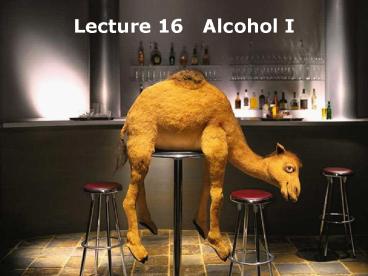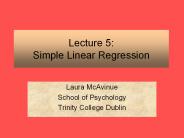Lecture 16 Alcohol I - PowerPoint PPT Presentation
1 / 18
Title:
Lecture 16 Alcohol I
Description:
Energy contribution: 29kJ/g (7kcal/g) no other nutrients with alcohol ... breathalyzer measures EtOH excreted through lungs. estimation of blood [EtOH] ... – PowerPoint PPT presentation
Number of Views:58
Avg rating:3.0/5.0
Title: Lecture 16 Alcohol I
1
Lecture 16 Alcohol I
2
Alcohol
- Chemically Ethanol (EtOH) Ethyl alcohol
- Energy contribution 29kJ/g (7kcal/g)
- no other nutrients with alcohol
- metabolized mainly in LIVER
- NO DIGESTION in SI
- absorbed intact, by simple diffusion
- 100 absorbed
3
Structure of Alcohol molecule
- H H
- H C C OH
- H H
- Ethanol is the hydrocarbon in beer, wine
spirits
4
Metabolism
- EtOH distributed to aqueous (fluid) parts of body
- moves easily through cell membranes
- but denatures proteins in cell membranes
- damage of LIVER
- from protein denaturation of cell membranes
- GI cells have shorter ½ life ? turnover more
quickly ? effectively less damage
5
Metabolism
- Main ENZYME in EtOH metabolism Alcohol
dehydrogenase (ADH) - gender differences
- males have ADH in gastric mucosa (stomach lining)
- females have minimal ADH in gastric mucosa
- ? females have higher amount of alcohol reaching
bloodstream liver c.f. males
6
Metabolism
- Factors inhibiting ADH activity
- 1. antihistimine drugs
- more EtOH reaches brain due to ?EtOH breakdown
(inhibited ADH activity) - ? drunker quicker
- not worth taking antihistimines B4 drinking (to
prevent hangover)
7
Metabolism
- 2. chronic EtOH abuse
- includes binge drinking
- ? ADH activity
- alcoholics get more drunk than non-alcoholics
- CANNOT build tolerance to EtOH
- 3. Ageing
- ? age, ? ADH activity
- ? drunker quicker
8
Metabolism
- Most EtOH consumed metabolised in liver
- small excreted via lungs, urine, sweat
- ? breathalyzer measures EtOH excreted through
lungs - estimation of blood EtOH
- directly quantitatively related
9
Metabolism
- Rate of EtOH metabolism
- An example
- wt 70kg, male
- metabolises b/w 7-14g EtOH per hour
- ? 0.7-1.5 standard drinks/hour
- ? 100-200mg EtOH/kg body weight/hour
- a standard alcoholic drink
10
Rate of alcohol metabolism
- when RATE EtOH consumption gt liver metabolic
capacity - ? blood alcohol
- intoxication symptoms appear as brain becomes
exposed to ? EtOH
11
Metabolism
- EtOH CANNOT be stored in the body
- EtOH 1st priority as a fuel source
- 3-pathways for EtOH metabolism
- a) alcohol dehydrogenase (ADH) pathway
- b) microsomal ethanol oxidising system (MEOS)
excess EtOH metabolism pathway - c) catalase (minor pathway)
12
Metabolism
- 3-pathways of EtOH metabolism
- ADH in stomach (males) ADH MEOS in liver
(males females) - Catalse in liver (males females)
13
Metabolism
- NOTE
- MEOS also involved in hepatic DRUG metabolism
- if MEOS mainly occupied with excess EtOH
metabolism - less MEOS available for drug metabolism
- if co-consumption of EtOH recreational drugs
(eg. THC, Ecstasy), then ?? prolonged effect
of the drugs ? potential drug overdose
14
Metabolism
- product of EtOH metabolism
- ACETALDEHYDE
- (hangover)
- Alcohol dehydrogenase
- EtOH Acetaldehyde
- NAD NADH H
- (Vitamin B3 co-enzyme)
15
Metabolism
- CoA
- Acetaldehyde ? Acetic Acid ? AcetylCoA
- NAD ?
- NADH H Krebs Cycle
- ?
- ATP synthesis
16
Metabolism
- Is alcohol converted into FAT in the body?
- ? NADH may promote Fatty Acid synthesis, but most
NADH is recycled to NAD - because EtOH is converted directly to Acetyl CoA,
C-atoms of alcohol not available - ? cannot be converted into CHO or FAT
- BUT
- ? EtOH consumption ? fat oxidation
- ME FIRST oxidation
17
Metabolism
- Euphoria
- the feelings of well-being associated with EtOH
consumption - binding of EtOH molecules to Endorphin receptors
in brain - EtOH binding with endorphin receptors stimulates
release of Dopamine in brain cells - Dopamine neurotransmitter ? euphoria
18
Recommended Reading
- 1. Whitney Rolfes
- Understanding Nutrition
- Chapter 7. Highlight. Alcohol and Nutrition. pp
240-249 - 2. German, J.B. Walzem, R.L. (2000)
- The Health Benefits of Wine
- Ann. Rev. Nutr. 20, 561-93































